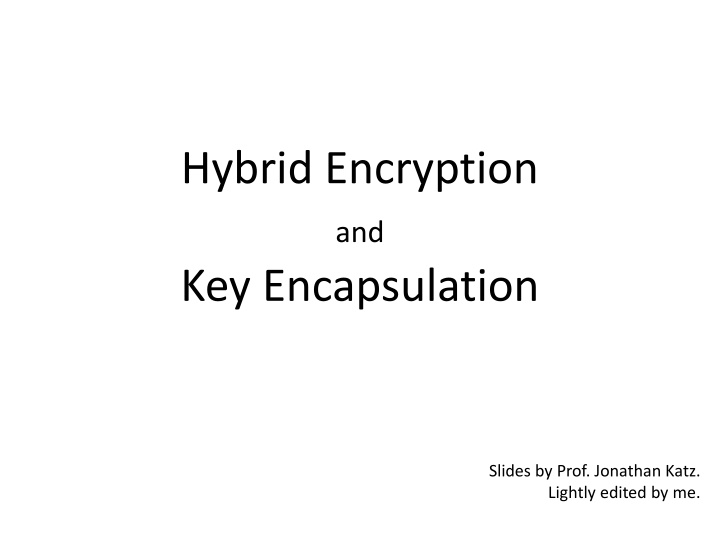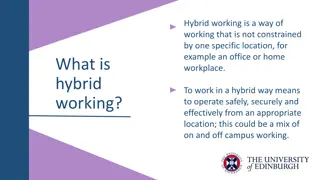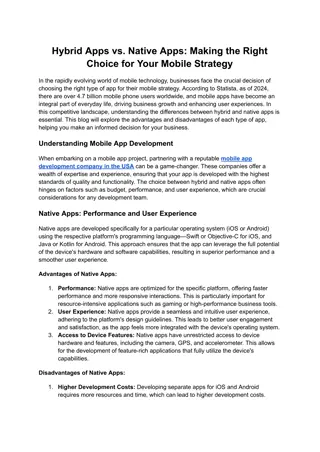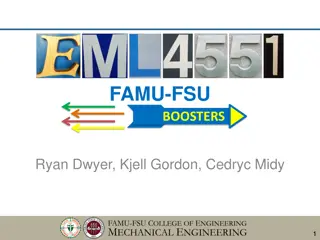
Hybrid Encryption and Key Encapsulation Slides Overview
Explore the concept of hybrid encryption, combining public-key and symmetric-key schemes for secure communication. Understand the encryption of long messages, benefits of hybrid encryption, and the efficiency it offers. Learn about the process of decryption and the security aspects of hybrid encryption.
Download Presentation

Please find below an Image/Link to download the presentation.
The content on the website is provided AS IS for your information and personal use only. It may not be sold, licensed, or shared on other websites without obtaining consent from the author. If you encounter any issues during the download, it is possible that the publisher has removed the file from their server.
You are allowed to download the files provided on this website for personal or commercial use, subject to the condition that they are used lawfully. All files are the property of their respective owners.
The content on the website is provided AS IS for your information and personal use only. It may not be sold, licensed, or shared on other websites without obtaining consent from the author.
E N D
Presentation Transcript
Hybrid Encryption and Key Encapsulation Slides by Prof. Jonathan Katz. Lightly edited by me.
Encrypting long messages Public-key encryption schemes natively defined for short messages E.g., El Gamal encryption How can longer messages be encrypted?
Encrypting long messages Can always encrypt block-by-block I.e., to encrypt M = m1, m2, , ml, do: Encpk(m1), , Encpk(ml) If the underlying scheme is CPA-secure (for short messages), then this is CPA-secure (for arbitrary length messages) What is the size of the ciphertext?
Note (Public-key) encryption is NOT a block cipher Fk is deterministic, one-to-one, and looks random Encpk is randomized (if it is CPA-secure), thus not one-to-one, and may not look random CTR-mode/CBC-mode don t make sense for public-key encryption
Encrypting long messages Encrypting block-by-block is inefficient Ciphertext expansion in each block Public-key encryption is expensive Can we do better?
Hybrid encryption Main idea Use public-key encryption to establish a (shared, secret) key k Use k to encrypt the message with a symmetric- key encryption scheme Benefits Lower ciphertext expansion Amortized efficiency of symmetric-key encryption
Hybrid encryption Decryption done in the obvious way m Enc ciphertext encapsulated key k Enc pk The functionality of public-key encryption at the (asymptotic) efficiency of private-key encryption! 7
Formally Let be a public-key scheme, and let be a symmetric-key scheme Define hy as follows: Genhy = Gen (i.e., same as ) Enchy(pk, m): Choose k {0,1}n c Encpk(k) c Enc k(m) Output c, c Decryption done in the natural way
Security of hybrid encryption If is a CPA-secure public-key scheme, and is a CPA-secure private-key scheme, then hy is a CPA-secure public-key scheme Suffices for to be EAV-secure If is a CCA-secure public-key scheme, and is a CCA-secure private-key scheme, then hy is a CCA-secure public-key scheme 9
Application to El Gamal? To use hybrid encryption with El Gamal, would need to encode key k as a group element Can we avoid this? The sender doesn t care about encrypting a specific key, it just needs to send a random key Idea: encrypt a random group element K; define the key as k = H(K)
KEMs For hybrid encryption, something weaker than public-key encryption suffices Sufficient to have a key encapsulation mechanism (KEM) that takes a public key and outputs a ciphertext c and a key k Correctness: k can be recovered from c given sk Security: k is indistinguishable from uniform given pk and c; can define CPA-/CCA-security Can still combine with symmetric-key encryption as before! Hybrid encryption KEM/DEM
KEMs For hybrid encryption, something weaker than public-key encryption suffices Sufficient to have a key encapsulation mechanism (KEM) that takes a public key and outputs a ciphertext c and a key k Correctness: k can be recovered from c given sk Security: k is indistinguishable from uniform given pk and c; can define CPA-/CCA-security Can still combine with symmetric-key encryption as before!
Security of KEM/DEM If is a CPA-secure KEM, and is a CPA- secure private-key scheme, then combination is a CPA-secure public-key scheme Suffices for to be EAV-secure If is a CCA-secure KEM, and is a CCA- secure private-key scheme, then combination is a CCA-secure public-key scheme 13
KEMs vs. PKE schemes For short messages, direct encryption using a PKE scheme (with no hybrid encryption) can sometimes be the best choice For anything longer, KEM/DEM or hybrid encryption will be more efficient This is how things are done in practice (unless very short messages are being encrypted)
KEM based on El Gamal Gen(1n) Run G(1n) to obtain G, q, g. Choose uniform x q. The public key is (G, q, g, gx) and the private key is x Ecapspk, where pk = (G, q, g, h) Choose uniform y q. The ciphertext is gy, and the key is k = H(hy) Decapssk(c), where sk = x Output k = H(cx) 15
Security? If the DDH assumption holds, and H is modeled as a random oracle, then this KEM is CPA-secure
Complete scheme Combine the KEM with private-key encryption I.e., encryption of message m is gy, Enc k(m), where k = H(hy) and Enc is a symmetric-key encryption scheme If Enc is CPA-secure and H is modeled as a random oracle, this is a CPA-secure public-key encryption scheme
Chosen-ciphertext security Under stronger assumptions, this approach can be proven to give CCA security If Enc is a CCA-secure symmetric-key scheme Can at least see why the previous attack no longer works Standardized as DHIES/ECIES 18
RSA-based KEM Idea: use plainRSA but on a random value! Then use that random value to derive a key
RSA-based KEM Encaps: Choose uniform r *N Ciphertext is c = [re mod N] Key is k = H(r) Decaps(c) Compute r = [cd mod N] Compute the shared key k = H(r)
Security? This KEM can be proven CCA-secure under the RSA assumption, if H is modeled as a random oracle
Comparison to RSA-OAEP? The RSA-KEM must be used with a symmetric- key encryption scheme For very short messages (< 1500 bits), RSA- OAEP will have shorter ciphertexts For anything longer, ciphertexts will be the same length; RSA-KEM is simpler






















